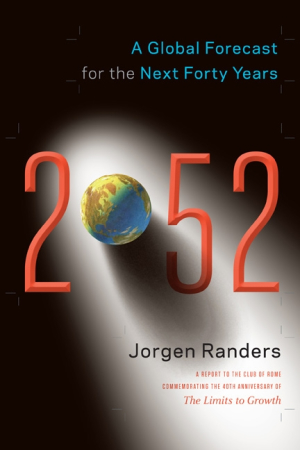2052
A Global Forecast for the Next Forty Years
As the countdown to the end of the Mayan calendar nears, humanity is being overwhelmed by a flood of doomsday messages. And while some obsess over the idea of a rock predicting the end of the world, most focus on the changing environment: what kind of world will future generations be looking at?
Four decades after coauthoring the groundbreaking and controversial Limits to Growth, Jorgen Randers offers a new look at a potential future in 2052: A Global Forecast for the Next Forty Years. The author has served as deputy director for the World Wildlife Fund International and on the sustainability board of the US-based Dow Chemical Company.
Presented as a report to The Club of Rome, a global think-tank, Randers uses three distinct methods to stitch together his forecast. The first, a simulation model with dynamic spreadsheets, follows standard and acceptable forecasting practices. His data, the model, and the spreadsheets are available on the book’s webpage for those who can understand them. For the lay reader, Randers provides a brief, simplified introduction to forecasting and modeling.
The second method highlights thirty-four essays, each under 1,500 words, written by a range of experts focusing on what they see happening within their area of study over the next forty years. These “glimpses,” as Randers refers to them, offer a mosaic of well-researched responses to current trends. Topics include advances in green technology and biofuels to urban development and intergenerational conflicts.
Randers’s responses to these glimpses, a blend of critique and interpretation, form his third method. An extremely careful communicator, Randers makes it a priority to make clear whether each statement and idea is based on the data, is an educated guess, or is something in which he strongly believes.
It’s impossible to avoid the personal nature of Randers’s report. Change cannot and does not happen without loss. And as the world changes, people are struggling to make sense of what they’re losing. For those in the transportation industry or involved with oil and gas exploitation, the Arctic’s melting icecap translates to new shipping routes and newly accessible reserves of fuel. For Randers, the pain of watching development continue to destroy his beloved old-growth forests led to profound advice from a psychologist friend. “Actively handle the grief, as one should after the loss of a mother or good friend. Accept the fact this this old growth was gone, and that more would be going. Look the future straight in the eye and accept it. Get used to how things are. Stop worrying.”
Only time will tell if Randers’s forecast is accurate. But his proactive approach to 2052: A Global Forecast for the Next Forty Years, provides the perfect, educated antidote to pessimists who predict the end of the world whenever it’s time to buy a new calendar.
Reviewed by
Joseph Thompson
Disclosure: This article is not an endorsement, but a review. The publisher of this book provided free copies of the book and paid a small fee to have their book reviewed by a professional reviewer. Foreword Reviews and Clarion Reviews make no guarantee that the publisher will receive a positive review. Foreword Magazine, Inc. is disclosing this in accordance with the Federal Trade Commission’s 16 CFR, Part 255.

